Detecting Partial Discharge in Cable Joints Based on Implanting Optical Fiber Using MZ–Sagnac Interferometry
Abstract
1. Introduction
2. Optical Fiber MZ-SI Ultrasonic Sensing System
2.1. Principle of Optical Fiber MZ-SI Sensing
- (a)
- 1-2-4-FRM-4-2-1;
- (b)
- 1-2-4-FRM-4-3-1;
- (c)
- 1-3-4-FRM-4-2-1;
- (d)
- 1-3-4-FRM-4-3-1.
2.2. Dual-Path Optical Fiber MZ-SI System Construction
3. Performance Testing of an Optical Fiber-Implanted Cable Joint
3.1. Electric Field Distribution of an Optical Fiber-Implanted Cable Joint
3.2. Preparation and Electrical Performance Testing of the Optical Fiber-Implanted Cable Joint
3.3. Response Characteristics of Optical Fiber Ultrasonic Sensors
4. PD Detection Test and Analysis Based on an Optical Fiber-Implanted Cable Joint
4.1. True-Type Cable Joint PD Test Platform
4.2. PD Results of Point Defect Tests
4.3. PD Results of Air Gap Defect Tests
4.4. PD Results of Discharge Along Surface Defect Tests
4.5. PD Results of Joint Misalignment Defect Tests
5. Conclusions
Supplementary Materials
Author Contributions
Funding
Institutional Review Board Statement
Informed Consent Statement
Data Availability Statement
Conflicts of Interest
References
- Zhou, C.; Yi, H.; Dong, X. Review of Recent Research towards Power Cable Life Cycle Management. High Volt. 2017, 2, 179–187. [Google Scholar] [CrossRef]
- Shahsavarian, T.; Shahrtash, S.M. Modelling of Aged Cavities for Partial Discharge in Power Cable Insulation. IET Sci. Meas. Technol. 2015, 9, 661–670. [Google Scholar] [CrossRef]
- Ra, N.; Mustafa, N.S.B.; Kawashima, T.; Murakami, Y.; Hozumi, N. Development of a Partial Discharge Measuring Method for a Long-Distance Cable Line. IEEJ Trans. Electr. Electron. Eng. 2019, 14, 996–1001. [Google Scholar] [CrossRef]
- Tian, Y.; Lewin, P.L.; Davies, A.E. Comparison of On-Line Partial Discharge Detection Methods for HV Cable Joints. IEEE Trans. Dielectr. Electr. Insul. 2002, 9, 604–615. [Google Scholar] [CrossRef]
- Sun, Y.; Lv, A.; Xie, Z. Analysis of Electric Field and Partial Discharge Characteristics of Cable Joint Stress Cone Dislocation Defects. IET Sci. Meas. Technol. 2024, 18, 231–244. [Google Scholar] [CrossRef]
- Song, Y.; Chen, W.; Zhang, Z.; Liu, F.; Wu, K.; Tian, H. Ultrasonic Sensing Technology of Partial Discharge Built into GIS Based on Fiber Optic Michelson Interferometry. High Volt. Eng. 2022, 48, 3088–3097. [Google Scholar] [CrossRef]
- Wu, R.; Chang, C. The Use of Partial Discharges as an Online Monitoring System for Underground Cable Joints. IEEE Trans. Power Deliv. 2011, 26, 1585–1591. [Google Scholar] [CrossRef]
- Li, S.; Li, J. Condition Monitoring and Diagnosis of Power Equipment: Review and Prospective. High Volt. 2017, 2, 82–91. [Google Scholar] [CrossRef]
- Ma, G.; Li, C.; Chen, X.; Jiang, J.; Ge, Z.-D.; Chang, W.-Z. Numerical Sensor Design for Partial Discharge Detection on Power Cable Joint. IEEE Trans. Dielectr. Electr. Insul. 2015, 22, 2311–2319. [Google Scholar] [CrossRef]
- Wu, J.; Rodrigo Mor, A.; van Nes, P.V.M.; Smit, J.J. Measuring Method for Partial Discharges in a High Voltage Cable System Subjected to Impulse and Superimposed Voltage under Laboratory Conditions. Int. J. Electr. Power Energy Syst. 2020, 115, 105489. [Google Scholar] [CrossRef]
- Huang, Z.; Zeng, Y.; Wang, R.; Ma, J.; Nie, Z.; Jin, H. Study on Ultrasonic Detection System for Defects inside Silicone Rubber Insulation Material. In Proceedings of the 2018 International Conference on Power System Technology (Powercon), Guangzhou, China, 6–9 November 2018; IEEE: New York, NY, USA, 2018; pp. 3651–3658. [Google Scholar]
- Liu, Z.; Yang, S.; Chen, Q.; Liu, Z.; Zhang, Z.; Li, Z.; Meng, X. Partial Discharge Distributed Locating in Power Cable Joints Using Φ-OTDR Optical Fiber System. IEEE Sens. J. 2024, 24, 14404–14412. [Google Scholar] [CrossRef]
- Chen, K.; Yue, Y.; Tang, Y. Research on Temperature Monitoring Method of Cable on 10 kV Railway Power Transmission Lines Based on Distributed Temperature Sensor. Energies 2021, 14, 3705. [Google Scholar] [CrossRef]
- Liu, H.; Zhang, Z.; Tian, H.; Song, Y.; Wang, J.; Shu, Z.; Chen, W. Comparison of Different Coupling Types of Fiber-Optic Fabry–Perot Ultrasonic Sensing for Detecting Partial Discharge Faults in Oil-Paper Insulated Equipment. IEEE Trans. Instrum. Meas. 2024, 73, 9519612. [Google Scholar] [CrossRef]
- Xie, Q.; Cheng, S.; Fangcheng Lü, F.; Li, Y. Location of Partial Discharge in Transformer Oil Using Circular Array of Ultrasonic Sensors. IEEE Trans. Dielectr. Electr. Insul. 2013, 20, 1683–1690. [Google Scholar] [CrossRef]
- Avzayesh, M.; Abdel-Hafez, M.F.; Al-Masri, W.M.F.; AlShabi, M.; El-Hag, A.H. A Hybrid Estimation-Based Technique for Partial Discharge Localization. IEEE Trans. Instrum. Meas. 2020, 69, 8744–8753. [Google Scholar] [CrossRef]
- Zhang, Z.; Yang, J.; Jia, J.; Hu, C.; Liu, Z.; Li, Y. Research on Partial Discharge State Detection in GIS Based on Internet of Things Technology. J. Phys. Conf. Ser. 2020, 1549, 042012. [Google Scholar] [CrossRef]
- Meitei, S.N. Partial Discharge Detection Using Piezoelectric Sensors on Power Transformer: A Review. IEEE Sens. J. 2024, 24, 13730–13742. [Google Scholar] [CrossRef]
- Zhang, Z.; Chen, W.; Wu, K.; Liu, H.; Chen, X.; Jiang, T.; Ma, Z.; Feng, W. Novel Approach for Partial Discharge Localization Based on Fiber-Optic F–P Sensing Array and Modified TDOA in a 110-kV Transformer. IEEE Trans. Instrum. Meas. 2024, 73, 9517711. [Google Scholar] [CrossRef]
- Chen, W.; Wang, J.; Wan, F.; Wang, P. Review of Optical Fibre Sensors for Electrical Equipment Characteristic State Parameters Detection. High Volt. 2019, 4, 271–281. [Google Scholar] [CrossRef]
- Liu, H.; Zhang, Z.; Song, R.; Shu, Z.; Wang, J.; Tian, H.; Song, Y.; Chen, W. Pattern Recognition Method for Detecting Partial Discharge in Oil-Paper Insulation Equipment Using Optical F-P Sensor Array Based on KAN-CNN Algorithm. J. Light. Technol. 2025, 1–9. [Google Scholar] [CrossRef]
- Liu, H.; Yang, T.; Zhang, Z.; Tian, H.; Song, Y.; Sun, Q.; Wang, W.; Geng, Y.; Chen, W. Ultrasonic Localization Method Based on Chan-WLS Algorithm for Detecting Power Transformer Partial Discharge Faults by Fibre Optic F-P Sensing Array. High Volt. 2024, 9, 1234–1245. [Google Scholar] [CrossRef]
- Song, Y.; Tian, H.; Jia, Z.; Chen, W.; Zhang, W.; Wang, C.; Zhou, T.; Li, L.; Hong, D.; Wang, Y.; et al. Distributed Partial Discharge Acoustic Signal Detection and Localization Technology for GIL with Built-in Fiber Optics. J. Light. Technol. 2024, 42, 5068–5076. [Google Scholar] [CrossRef]
- Qin, W.; Ma, G.; Wang, S.; Hu, J.; Guo, T.; Shi, R.-B. Distributed Discharge Detection Based on Improved COTDR Method with Dual Frequency Pulses. IEEE Trans. Instrum. Meas. 2023, 72, 9001308. [Google Scholar] [CrossRef]
- Che, Q.; Wen, H.; Li, X.; Peng, Z.; Chen, K.P. Partial Discharge Recognition Based on Optical Fiber Distributed Acoustic Sensing and a Convolutional Neural Network. IEEE Access 2019, 7, 101758–101764. [Google Scholar] [CrossRef]
- Cheng, Y.; Hao, Y.; Tian, W.; Zhao, P.; Tan, H.; Li, Q.; Li, L. Distributed Optical Fiber Detection Based on BOTDR for Buffer Layer Defects of High-Voltage XLPE Cable with Corrugated Aluminum Sheath. IEEE Trans. Dielectr. Electr. Insul. 2024, 31, 1778–1787. [Google Scholar] [CrossRef]
- Sun, Y.; Lv, A.; Xie, Z.; Kong, Y. Research on Partial Discharge Detection Based on Distributed Optical Fiber Acoustic Sensor. Meas. Sci. Technol. 2024, 35, 086011. [Google Scholar] [CrossRef]
- Liu, Z.; Wang, Y.; Chen, X.; Meng, X.; Liu, X.; Yao, J. An Optical Fiber Sensing Method for Partial Discharge in the HVDC Cable System. Int. J. Electr. Power Energy Syst. 2021, 128, 106749. [Google Scholar] [CrossRef]
- Hao, Y.; Chen, Y.; Chen, Y.; Huang, T.; Xiao, J.; Yang, L. A Partial Discharge Detection System for XLPE Cable Terminals and Acoustic Wave Sensing Characteristics Based on Fiber Optic Mach-Zehnder Interferometer. IEEE Sens. J. 2021, 21, 21782–21790. [Google Scholar] [CrossRef]
- Qin, W.; Ma, G.; Hu, J.; Guo, T.; Wang, S.; Liu, H.; Wang, Y. Distributed Detection and Acoustic Emission Waveform Retrieval of Cable Joint Partial Discharge. IEEE Trans. Power Deliv. 2023, 38, 2977–2980. [Google Scholar] [CrossRef]
- Li, H.; Li, C.; Zhao, D.; Wu, H.; Hong, G.; Zhou, P.; Peng, H.; Mi, Q.; Xu, Q.; Wang, C.; et al. Research Progress on MZ-Sagnac Interferometric Distributed Optical Fiber Vibration Sensing Technology. Laser Optoelectron. Prog. 2024, 61, 1300008. [Google Scholar] [CrossRef]
- Liu, K.; Jin, X.; Jiang, J.; Xu, T.; Ding, Z.; Huang, Y.; Sun, Z.; Xue, K.; Li, S.; Liu, T. Interferometer-Based Distributed Optical Fiber Sensors in Long-Distance Vibration Detection: A Review. IEEE Sens. J. 2022, 22, 21428–21444. [Google Scholar] [CrossRef]
- Fang, X. Fiber-Optic Distributed Sensing by a Two-Loop Sagnac Interferometer. Opt. Lett. 1996, 21, 444–446. [Google Scholar] [CrossRef] [PubMed]
- Zhou, Y.; Wang, Y.; Wang, W. A Study on the Propagation Characteristics of Partial Discharge in Cable Joints Based on the FDTD Method. IEEE Access 2020, 8, 130094–130103. [Google Scholar] [CrossRef]
- Wei, P.; Shan, X.; Sun, X. Frequency Response of Distributed Fiber-Optic Vibration Sensor Based on Nonbalanced Mach-Zehnder Interferometer. Opt. Fiber Technol. 2013, 19, 47–51. [Google Scholar] [CrossRef]
- GB/T 11017.3-2014; Power Cables with Cross-Linked Polyethylene Insulation and Their Accessories for Rated Voltage of 110 kV (Um = 126 kV)—Part 3:Accessories. State Administration for Market Regulation: Beijing, China, 2014.
- JJF 1337-2012; Calibration Specification for Acoustic Emission Sensors (Comparative Method). General Administration of Quality Supervision, Inspection and Quarantine of the People’s Republic of China: Beijing, China, 2012.
- Barbieri, L.; Villa, A.; Malgesini, R.; Palladini, D.; Laurano, C. An Innovative Sensor for Cable Joint Monitoring and Partial Discharge Localization. Energies 2021, 14, 4095. [Google Scholar] [CrossRef]
- IEC 60270:2015; High-Voltage Test Techniques—Partial Discharge Measurements. International Electrotechnical Commission: Geneva, Switzerland, 2015.
- GB/T 7354-2018; High-Voltage Test Techniques—Partial Discharge Measurements. Standardization Administration of China: Beijing, China, 2018.
- Lai, Q.; Xu, C.; Wang, G.; Deng, M. Assessment of Aging Degradation in Rubber Using Quasi-Static Components of Ultrasonic Longitudinal Waves. J. Nondestruct. Eval. Diagn. Progn. Eng. Syst. 2024, 8, 021007. [Google Scholar] [CrossRef]
- Wang, X.; Chang, J.; Shan, Y.; Tie, S.; Yao, M.; Xu, J. Measurement of Attenuation of Ultrasonic Propagating through the Thin Layer Media with Time Delay Spectrum. Chin. J. Mech. Eng. 2010, 23, 129–134. [Google Scholar] [CrossRef]
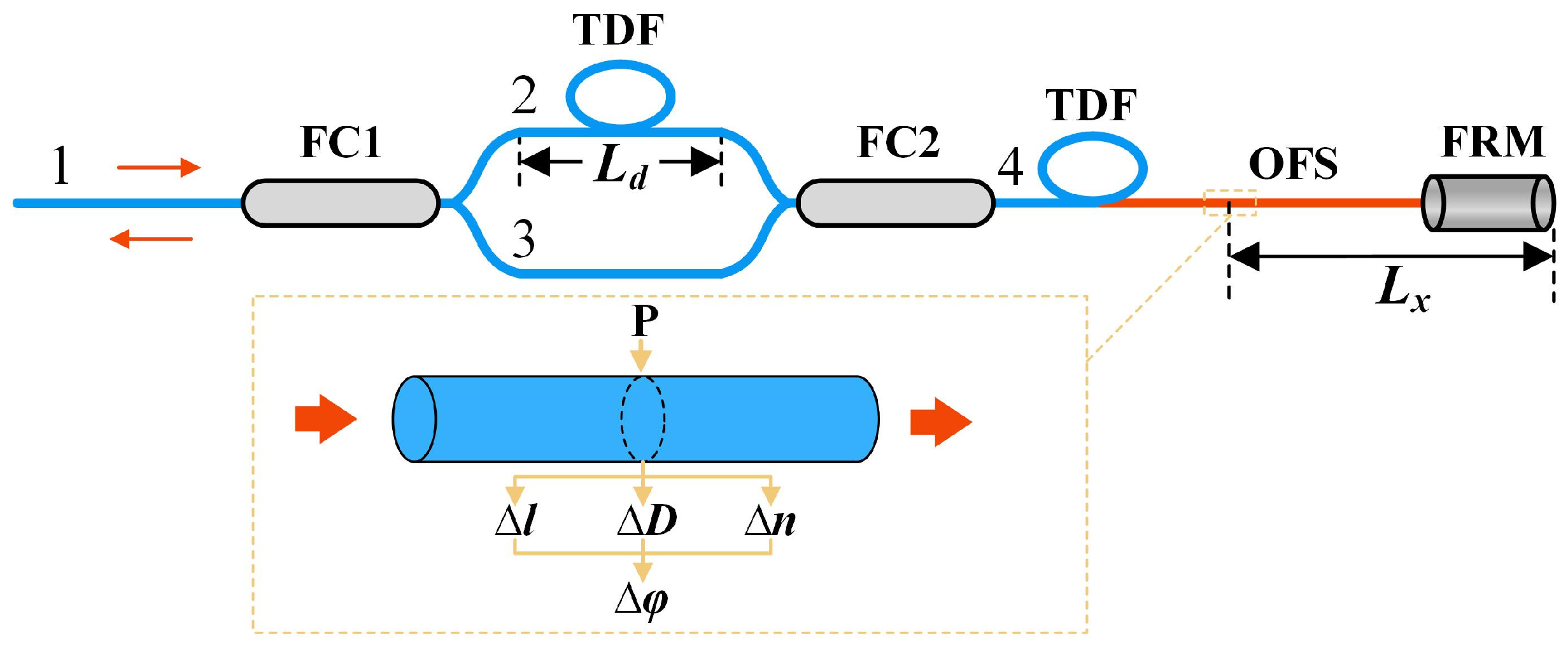
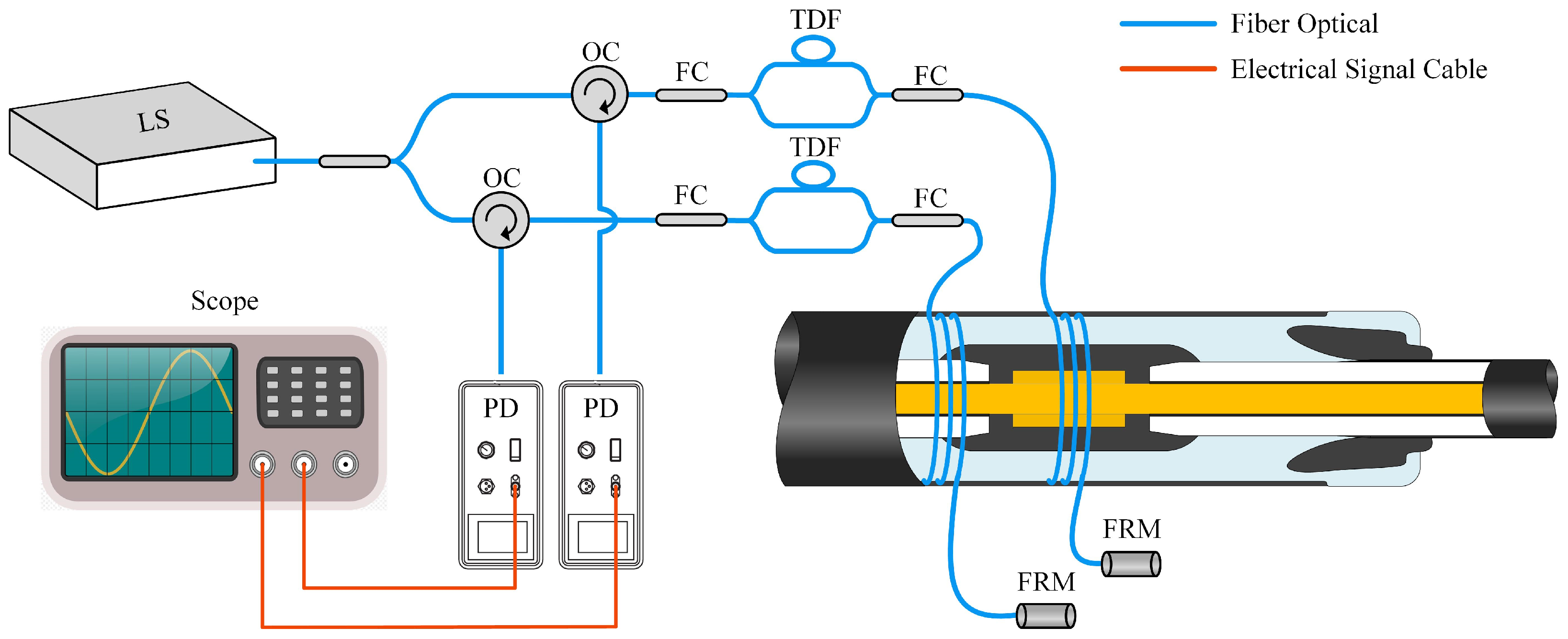
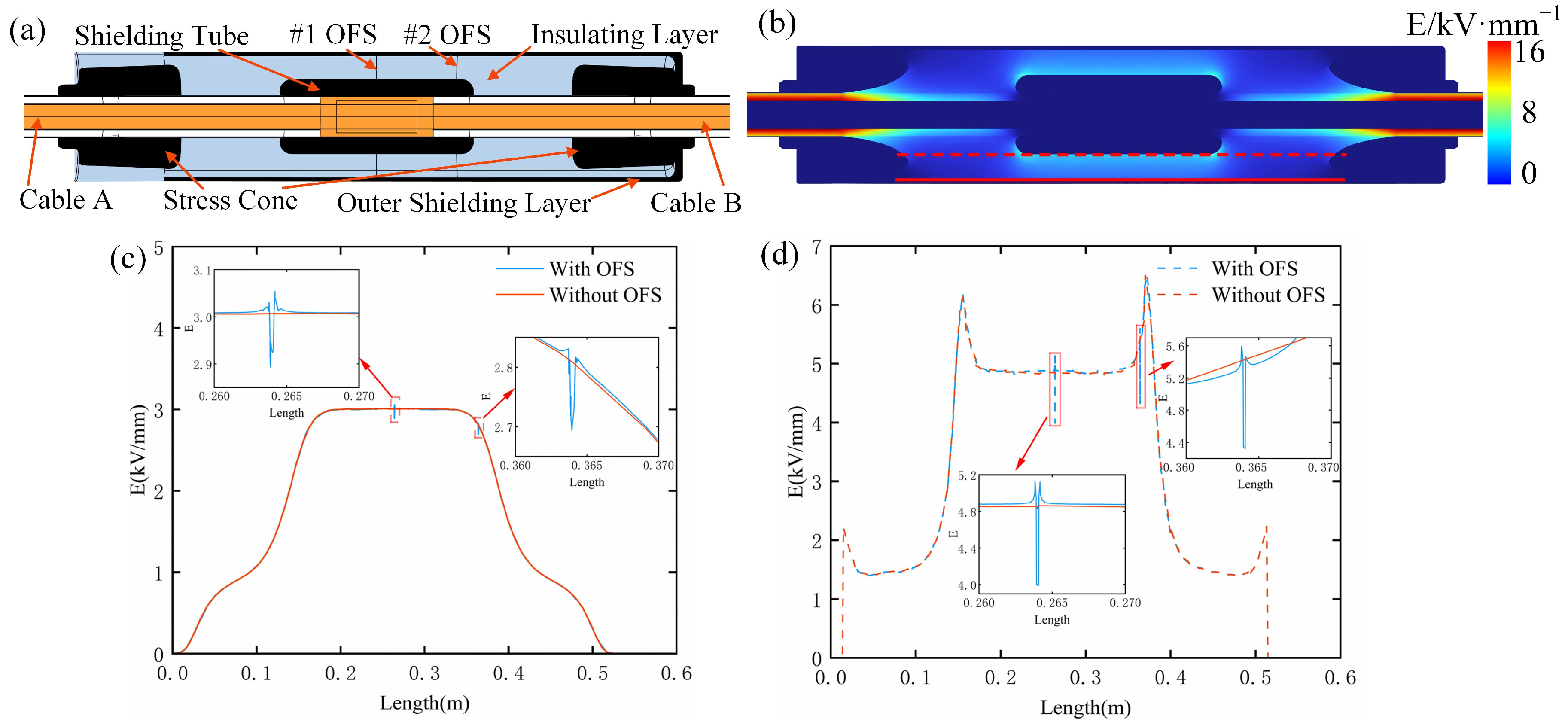
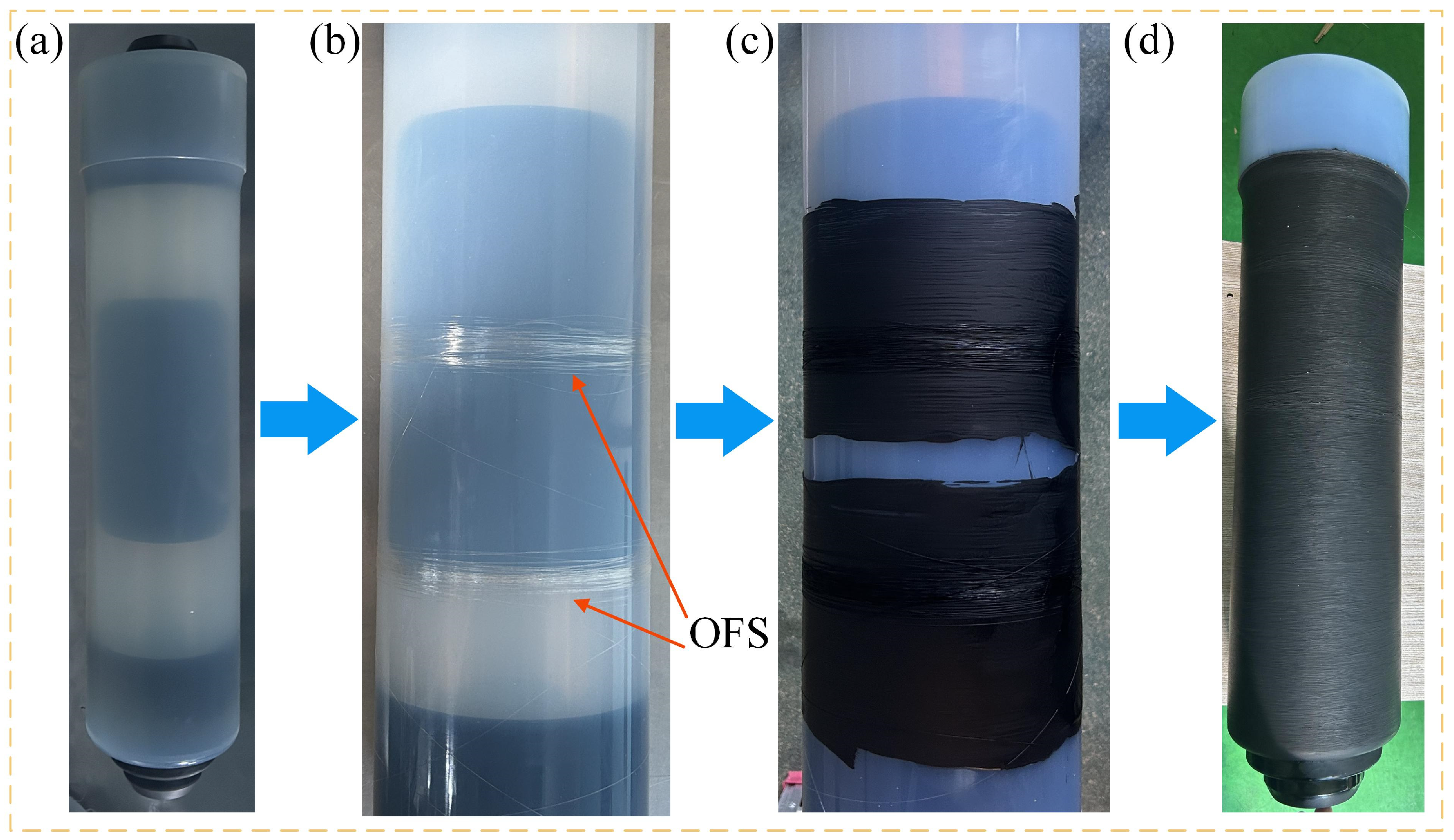
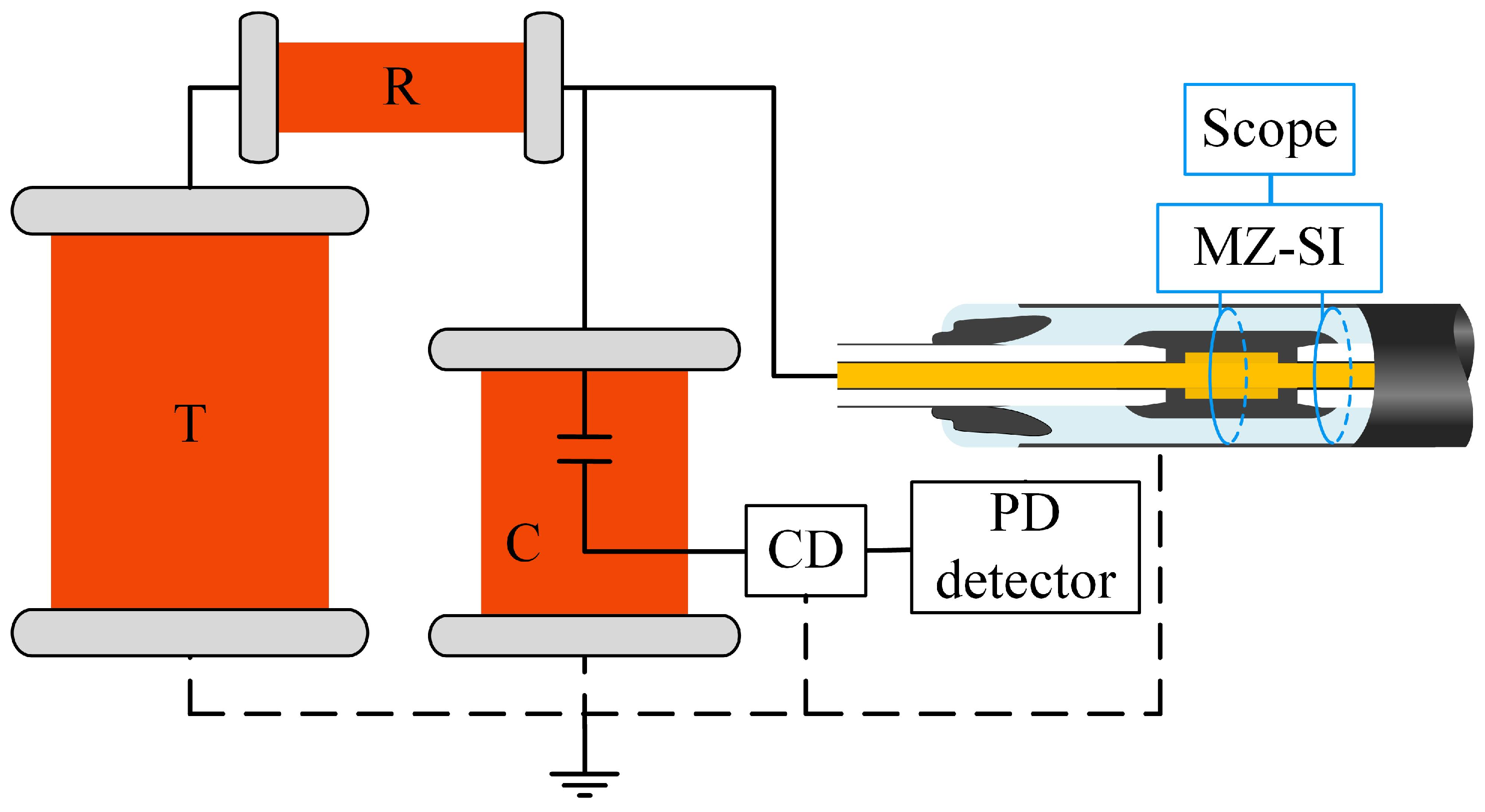
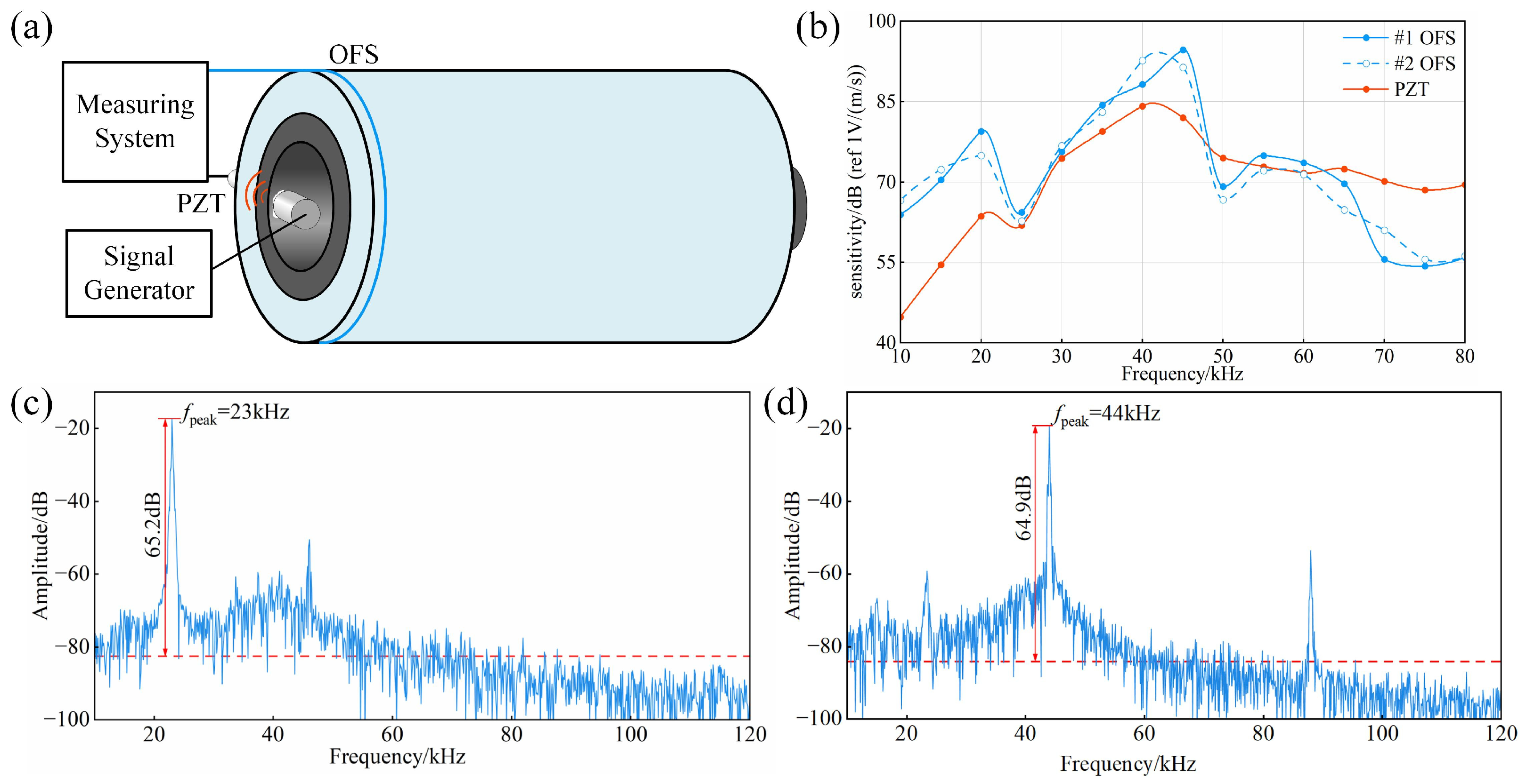
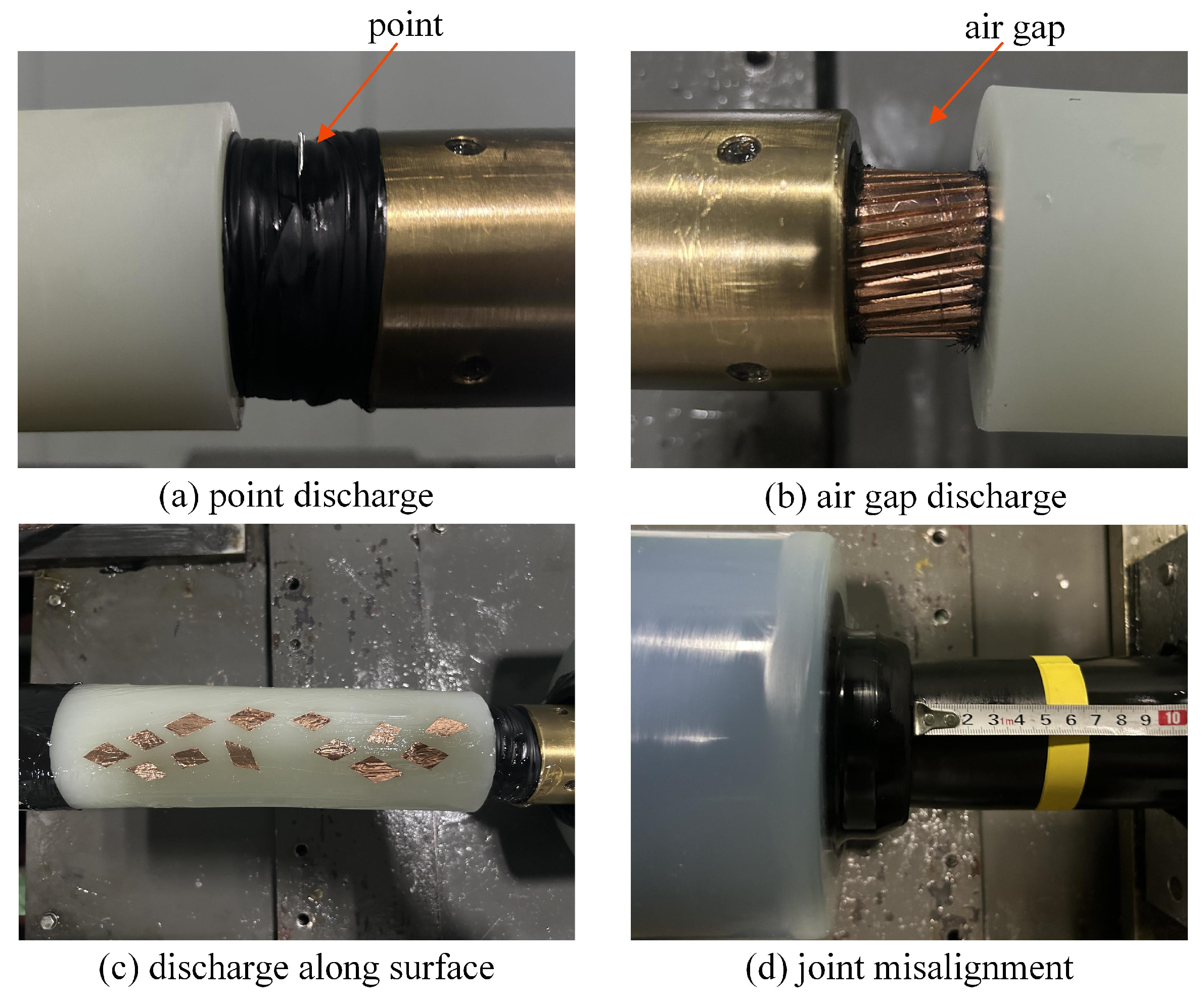
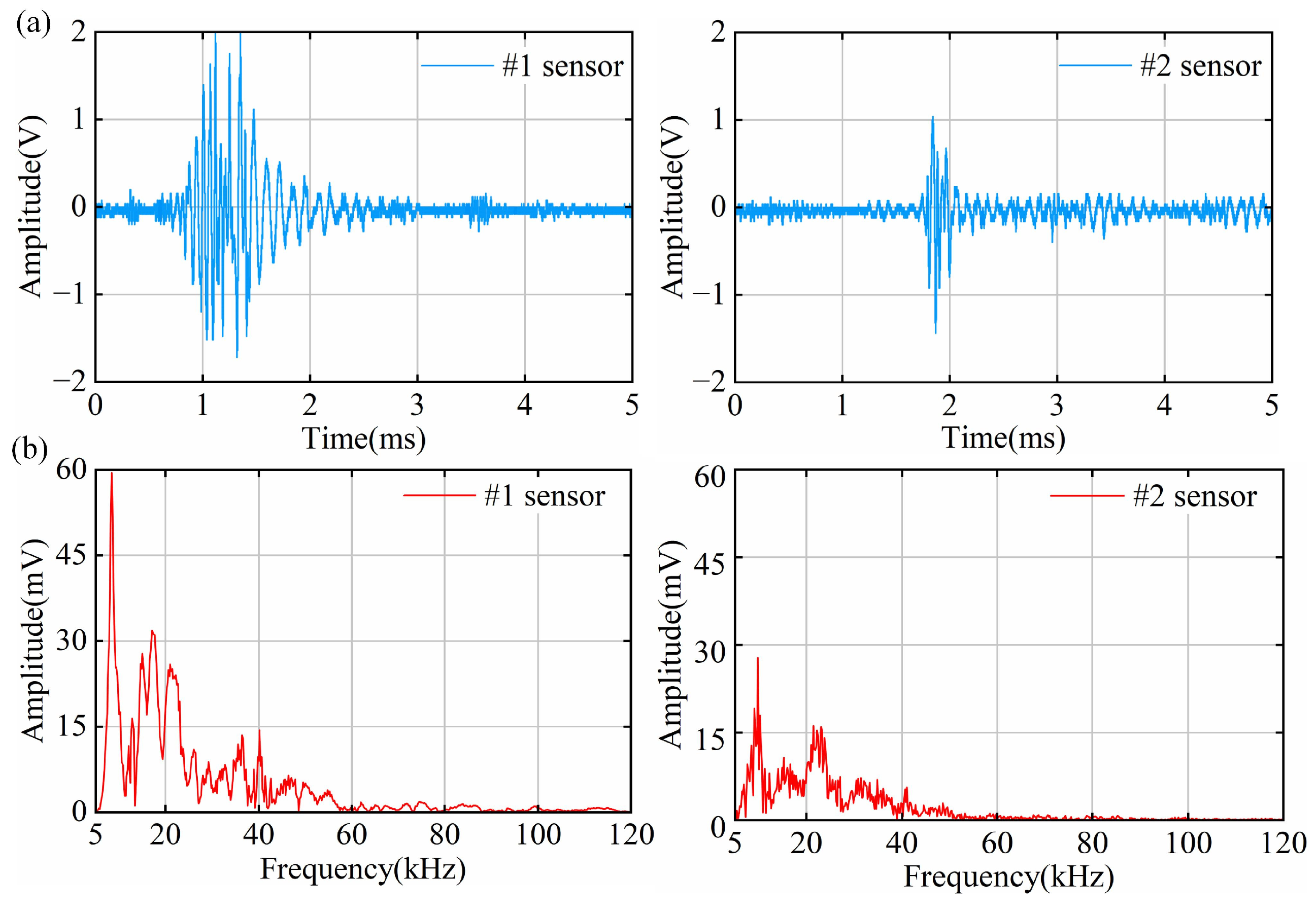
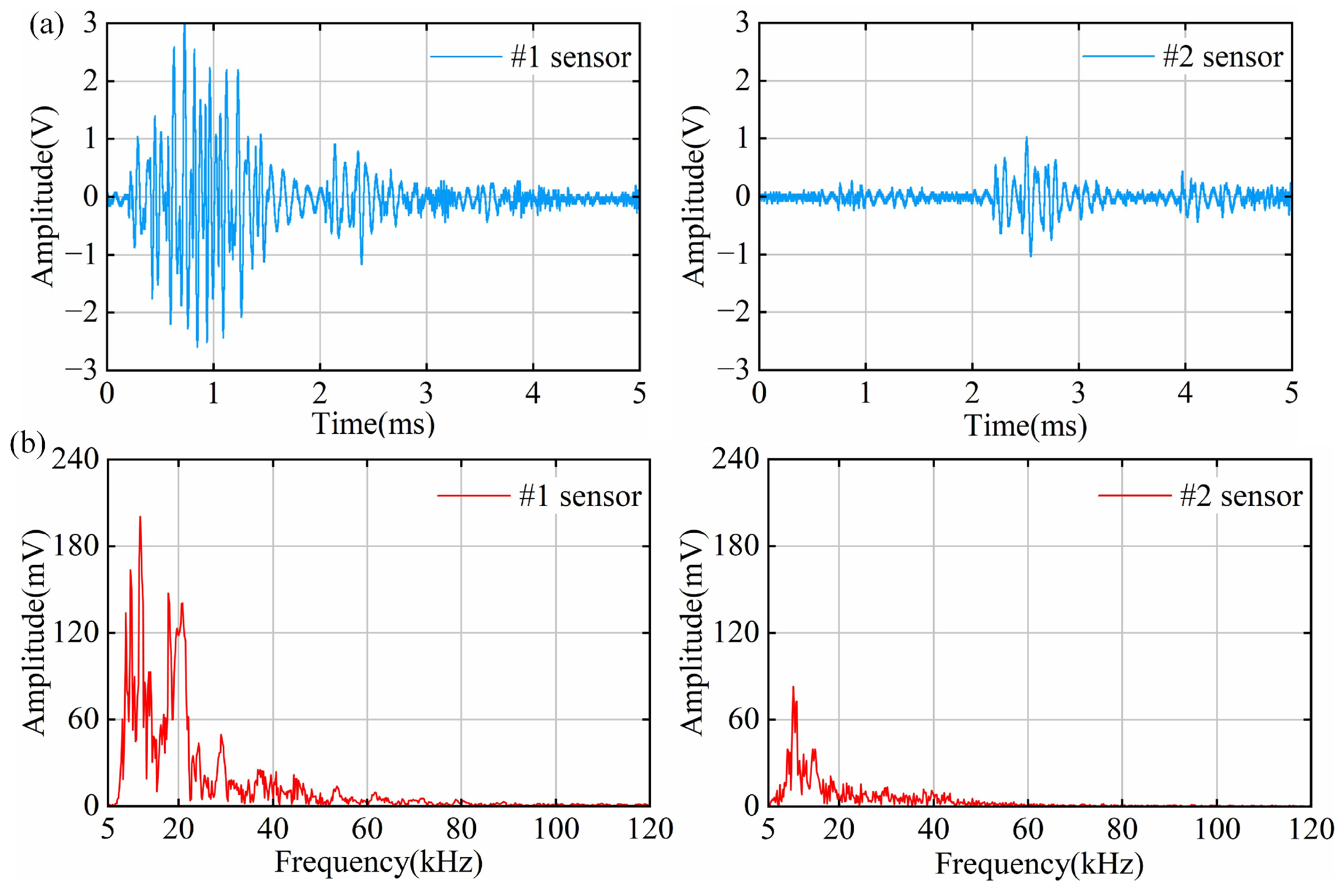
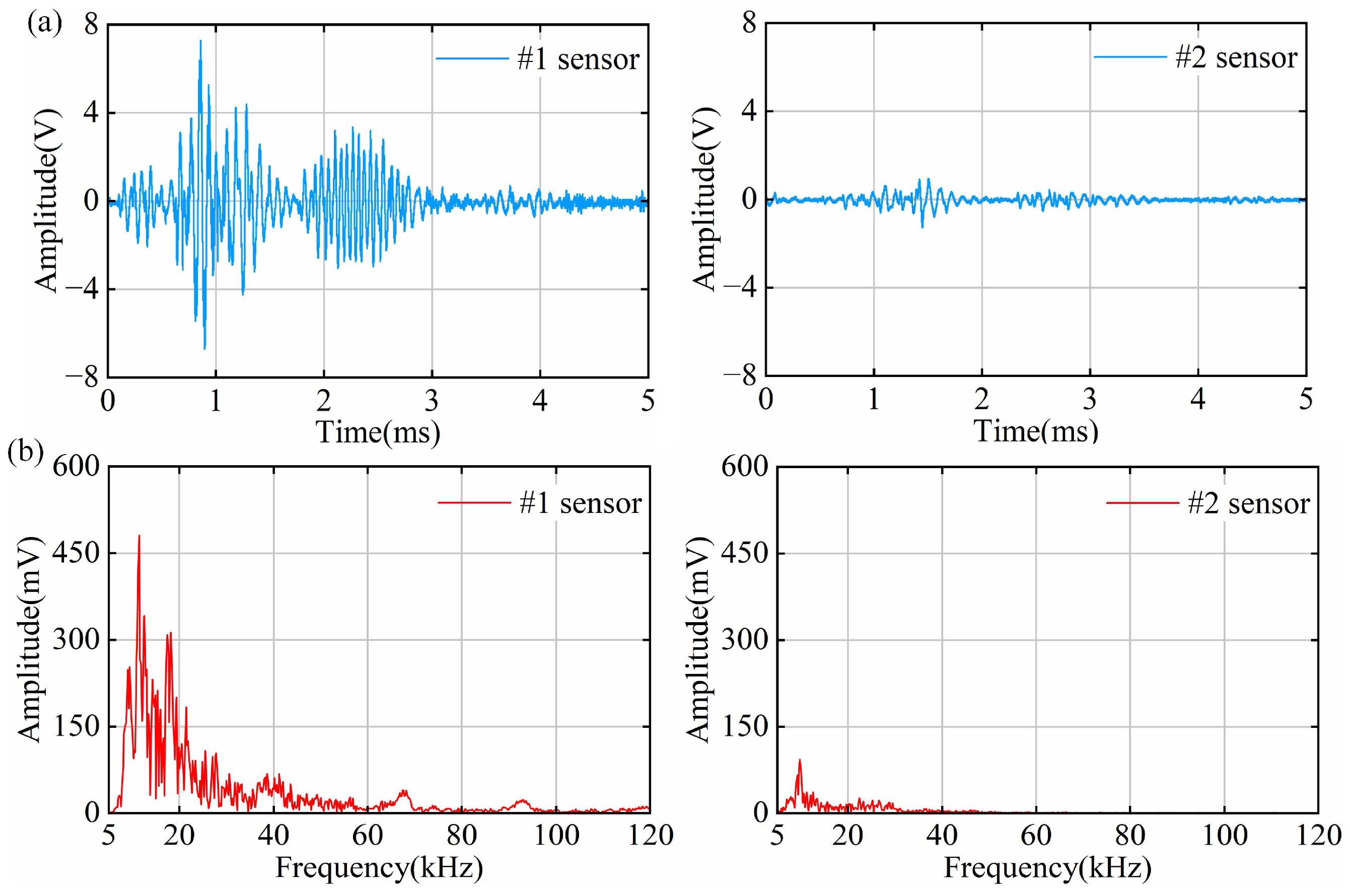

| Material | Relative Permittivity | Conductivity (S/m) |
|---|---|---|
| semi-conducting silicone rubber | 5.99 | 3.30 |
| insulating silicone rubber | 3.20 | 1 × 10−18 |
| semi-conducting XLPE | 2.30 | 2.30 |
| insulating XLPE | 2.60 | 1× 10−18 |
| copper | 1 | 6 × 107 |
| optical fiber | 3.75 | 1× 10−14 |
Disclaimer/Publisher’s Note: The statements, opinions and data contained in all publications are solely those of the individual author(s) and contributor(s) and not of MDPI and/or the editor(s). MDPI and/or the editor(s) disclaim responsibility for any injury to people or property resulting from any ideas, methods, instructions or products referred to in the content. |
© 2025 by the authors. Licensee MDPI, Basel, Switzerland. This article is an open access article distributed under the terms and conditions of the Creative Commons Attribution (CC BY) license (https://creativecommons.org/licenses/by/4.0/).
Share and Cite
Zhang, W.; Song, Y.; Wu, X.; Liu, H.; Tian, H.; Tang, Z.; Xu, S.; Chen, W. Detecting Partial Discharge in Cable Joints Based on Implanting Optical Fiber Using MZ–Sagnac Interferometry. Sensors 2025, 25, 3166. https://doi.org/10.3390/s25103166
Zhang W, Song Y, Wu X, Liu H, Tian H, Tang Z, Xu S, Chen W. Detecting Partial Discharge in Cable Joints Based on Implanting Optical Fiber Using MZ–Sagnac Interferometry. Sensors. 2025; 25(10):3166. https://doi.org/10.3390/s25103166
Chicago/Turabian StyleZhang, Weikai, Yuxuan Song, Xiaowei Wu, Hong Liu, Haoyuan Tian, Zijie Tang, Shaopeng Xu, and Weigen Chen. 2025. "Detecting Partial Discharge in Cable Joints Based on Implanting Optical Fiber Using MZ–Sagnac Interferometry" Sensors 25, no. 10: 3166. https://doi.org/10.3390/s25103166
APA StyleZhang, W., Song, Y., Wu, X., Liu, H., Tian, H., Tang, Z., Xu, S., & Chen, W. (2025). Detecting Partial Discharge in Cable Joints Based on Implanting Optical Fiber Using MZ–Sagnac Interferometry. Sensors, 25(10), 3166. https://doi.org/10.3390/s25103166






